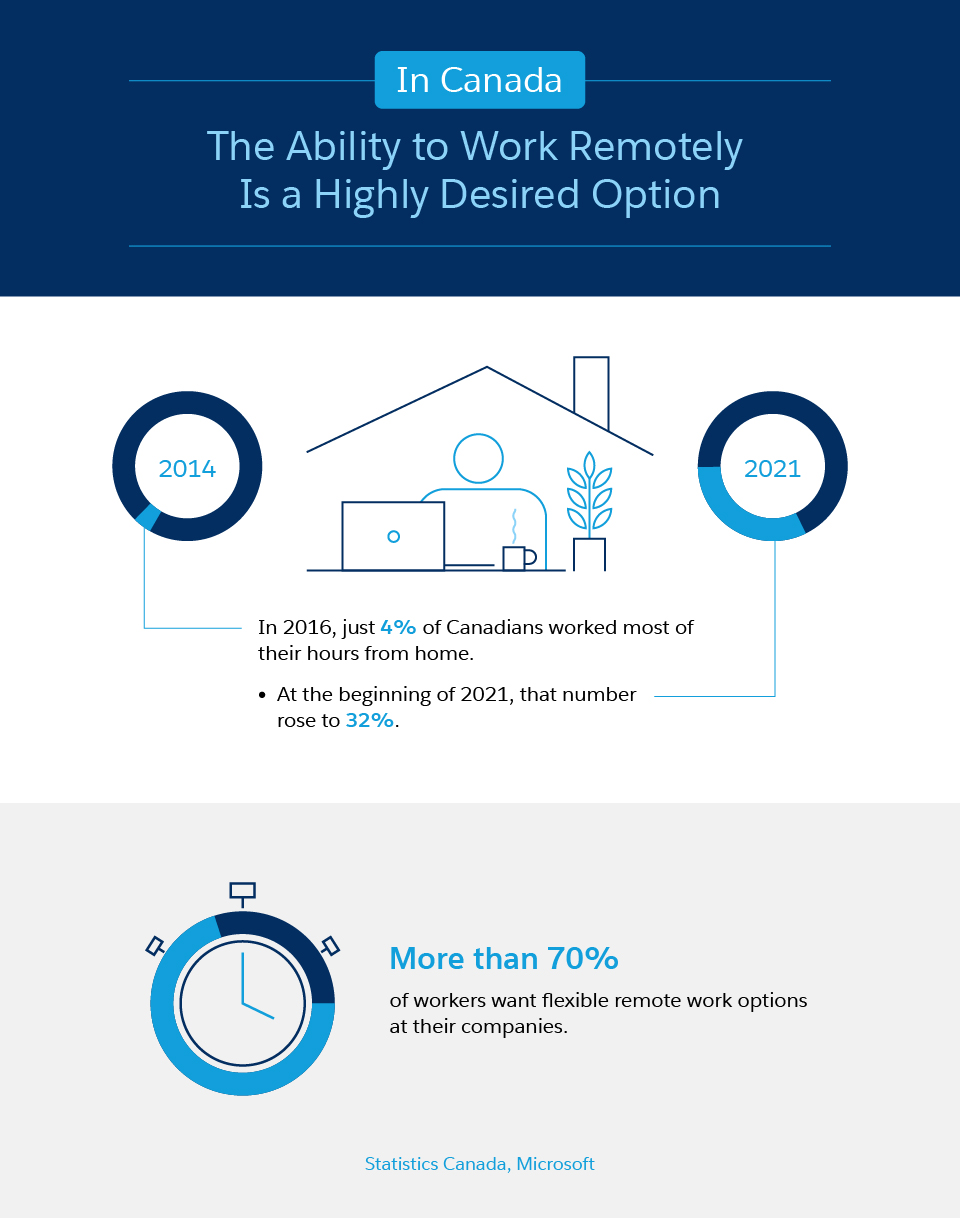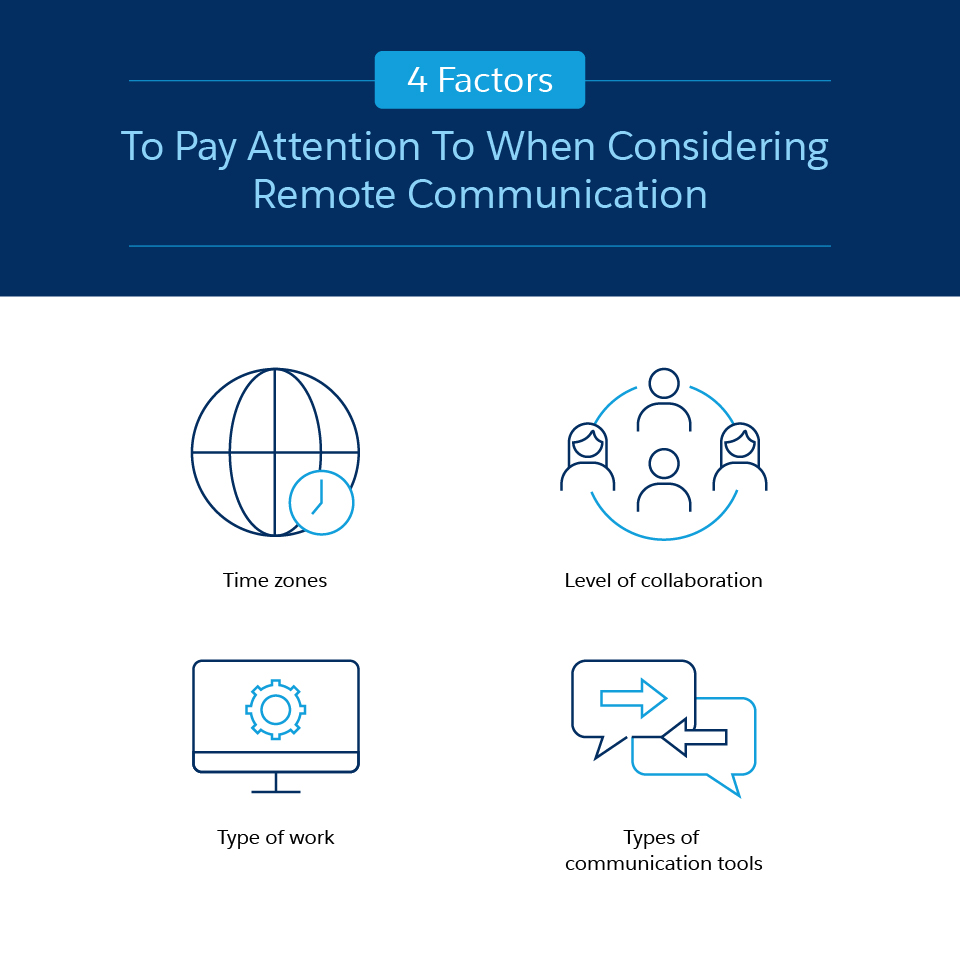In 2016, just 4 per cent of Canadian employees worked most of their hours from home. At the beginning of 2021, that number had risen to 32 per cent. In the last two years, the number of remote workers soared — and many found they enjoyed the flexibility, comfort, and lack of commute. Some workers like remote work so much they are quitting their jobs at companies without remote work options, rather than go back to the office full time.
According to a global survey conducted by Microsoft and LinkedIn, more than 70 per cent of workers would like flexible remote work options to continue; however, 65 per cent want to have more in-person time with their teams. The conclusion of the survey: “extreme flexibility and hybrid work” are what employees want and will define the new workplace.
What does that mean for communication and team building? To be successful, companies must navigate building strong teams with limited or no in-person time. That means adjusting how we communicate, build communities, and collaborate at work.
Here are six techniques to keep the lines of communication open, whether you work with a fully remote team, have a hybrid work model, or have employees who occasionally work on the road.

Consider What Your Team and Employees Need
It may be that not all teams within your business have the same needs, or that your company’s communication needs will look the same as a competitor’s. Large companies with thousands of employees will have different needs than small teams with flat hierarchies. Add in remote working, and the list of variables to consider grows even more.
Before creating a communication plan, think about your team’s unique needs and what strategies will help your team grow. Here are a few factors to consider when developing a remote communication plan:
Time zones: Are most of your employees in the same or similar time zones? This can impact when you host all-hands meetings, manager one-on-ones, or virtual events.
Level of collaboration: Do teams work closely together throughout the week? They may not need a meeting or event to improve collaboration. On the other hand, teams that perform most of their work independently may benefit from increased levels of communication to reduce feelings of isolation or siloed work.
Type of work: Teams that work on deep, flow-state work, such as coding or writing, may be frustrated by more or impromptu meetings, while teams that interact with clients may welcome the opportunity to connect with their co-workers and management over chat or email.
Types of communication tools: Your team likely has access to a number of channels for communicating, including email, messaging platforms, phone calls, video calls, group messages, texting, and more.
The best way to find out what your team needs is to ask. Send out a survey asking how connected they feel, whether they feel heard, and if the current communication practices work for them. Gather data, both qualitative and quantitative, and create or adjust your communication strategy accordingly.

Establish Communication Norms
It's hard to keep up with all the communication channels. Should you send that message via email, a private message, or text, or should you pick up the phone and call? Do you have the relevant information for the conversation in an email or your CRM platform?
Establishing norms improves communication by making it clear how specific information should be shared. For example, if your company uses an internal messaging platform, that may be your preferred communication channel for all client work, but memes and meeting invites go through email. Any conversations that include client work may need to be documented and summarized in your CRM. Being clear with standards prevents employees from wasting time sorting through emails or different channels.
Keep in mind that communication norms may vary by team. A sales team might choose to communicate in the CRM because it pulls information from other tools, while marketing might prefer to use a communication platform where they have separate channels for each client.
Create a Virtual Watercooler
Remote teams may be just as or more productive than in-office teams, but they miss the opportunity for casual conversations and impromptu chats. Those conversations can improve collaboration and build relationships.
Like their in-person counterparts, virtual water coolers allow employees to build a community, which can translate into better working relationships. Social interactions, remote or otherwise, can also reduce feelings of isolation.
Virtual water coolers can include:
Weekly or monthly coffee meet-ups on video
Games or team-building activities
Watercooler channels on messaging platforms or group threads
Icebreaker conversations, such as favourite television shows or video games
Virtual water coolers aren't just good for team bonding; they also create an opportunity for those spontaneous conversations that occur in the office by the coffee cart or while eating lunch in the breakroom. Just be careful not to overwhelm workers who already spend hours in meetings. Keep it fun and make it optional.
Make the Most of One-on-Ones
One-on-one meetings are key to developing successful feedback loops between managers and direct reports. They give each person an opportunity to discuss challenges, celebrate successes, and touch base about specific projects. However, they can also help build a more personal relationship.
When it’s appropriate, use some one-on-one time to talk about life outside of work. What television shows are you watching, what sports teams are you into? Discussing non-work-related topics for a few minutes provides much-needed social interactions and can help managers and their direct reports develop a deeper relationship, which can improve the working relationship.

Be Mindful About Video Calls
Video calls allow teams to collaborate across the world in real-time and in a more personal way. For many businesses, they're a crucial element in successfully moving to a remote workforce. However, there are drawbacks to video calls that need to be considered.
For starters, video calls can disrupt work. Having time to block out distractions and focus on getting work done is difficult when you're in back-to-back calls all day. Lagging internet connections and differences in time zones can also reduce the efficiency of video meetings.
Don't overcompensate for lack of in-person time by requiring a video call for every meeting. Instead, use video calls sparingly, such as during team-building activities or when visual cues are important, such as meeting with a new client or a job interview.
Schedule Team-Building Activities
Strategically designed team-building activities promote communication and community in remote and hybrid teams. They can increase employee morale and reduce feelings of isolation that some fully remote workers feel.
Increasing remote team engagement requires careful consideration. Events should aim to create personal connections between the employees and their teams. Start with ice breakers, such as rose, bud, thorn conversations, where each member shares something they’re thankful for, something they’re looking forward to, and a challenge they're facing. Avoid overly general ice breakers, such as "tell me something interesting about yourself." Instead, cover topics such as the last book you read, the most recent show you binge-watched, or the worst style choice you've ever made.
After the icebreaker, move on to a more formal team-building event, such as:
Lunch and learns
Group games, like trivia
Virtual book clubs
Virtual escape rooms
Schedule team-building activities regularly, but not so often that they become a chore. Once a month or biweekly is often enough to build relationships without taking over work time.
Build a Communication Plan That Works for You
The same approach won't work for every business, team, or employee. Use your surveys to gather feedback so you can change tactics as necessary. For example, do employees enjoy team-building exercises, or do these events pull team members away from meaningful work? Is there anything they'd like to see change? Remember, too, that some team members may be more social or extroverted than others. Provide several optional methods to ensure everyone experiences the level of communication they need.
Whether your team is full-time remote, occasionally remote while traveling for work, or some hybrid version, creating and maintaining open lines of communication is critical for long-term success. Hosting team-building events and creating virtual watercooler channels can create a sense of belonging that improves mental health — and inspires productivity.


